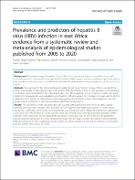| dc.description.abstract | Background: The epidemiology of hepatitis B virus (HBV) in the general population in east Africa is not well
documented. In this meta-analysis, we examined 37 full published research articles to synthesise up-to-date data on
the prevalence and predictors of the HBV burden for the effective prevention and management of the virus in our
region.
Methods: We examined 37 full published research articles found using PubMed, Scopus, African Journal Online
(AJOL), and Google Scholar between May and October 2020. Dichotomous data on HBV prevalence and predictors
of infection were extracted from the individual studies. The HBV prevalence, test of proportion, relative risk, and I2
statistics for heterogeneity were calculated using MedCalc software version 19.1.3. Begg’s tests was used to test for
publication bias. Sources of heterogeneity were analysed through sensitivity analysis, meta-regression, and subgroup
analysis at 95% CI. P < 0.05 was considered significant for all analyses.
Results: The prevalence of HBV was generally high (6.025%), with publications from Kenya (8.54%), Uganda
(8.454%) and those from between 2011 and 2015 (8.759%) reporting the highest prevalence (P < 0.05). Blood
transfusion, scarification, promiscuity, HIV seropositivity, and being male were independent predictors significantly
associated with HBV infection (P < 0.05), with the male sex being the most strongly associated predictor of HBV
infection. Meta-regressions for the pooled HBV prevalence and sample size, as well as the year of publication,
lacked statistical significance (P > 0.05). Omitting the study with the largest sample size slightly increased pooled
HBV prevalence to 6.149%, suggesting that the studies are robust. Begg’s test showed no evidence of publication
bias for overall meta-analysis (p > 0.05).
Conclusion: The burden of HBV is still high, with the male sex, blood transfusion, body scarification, and HIV
seropositivity being potential predictors of infection. Thus, it is important to scale up control and prevention
measures targeting persons at high risk. | en_US |

